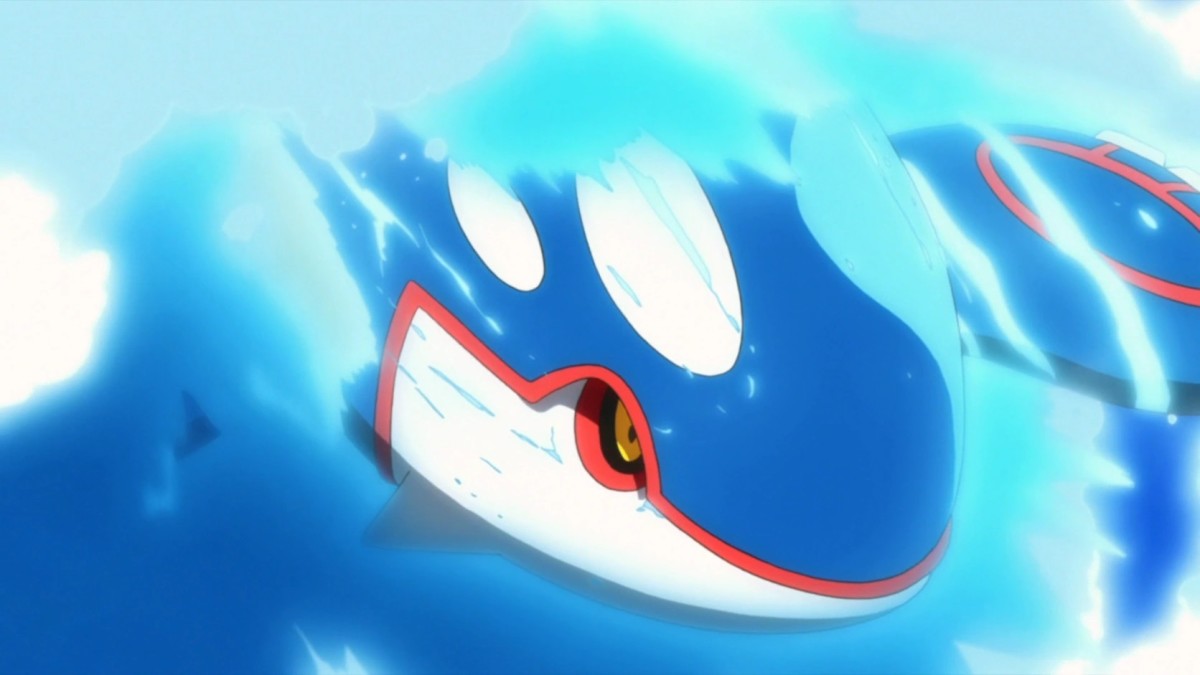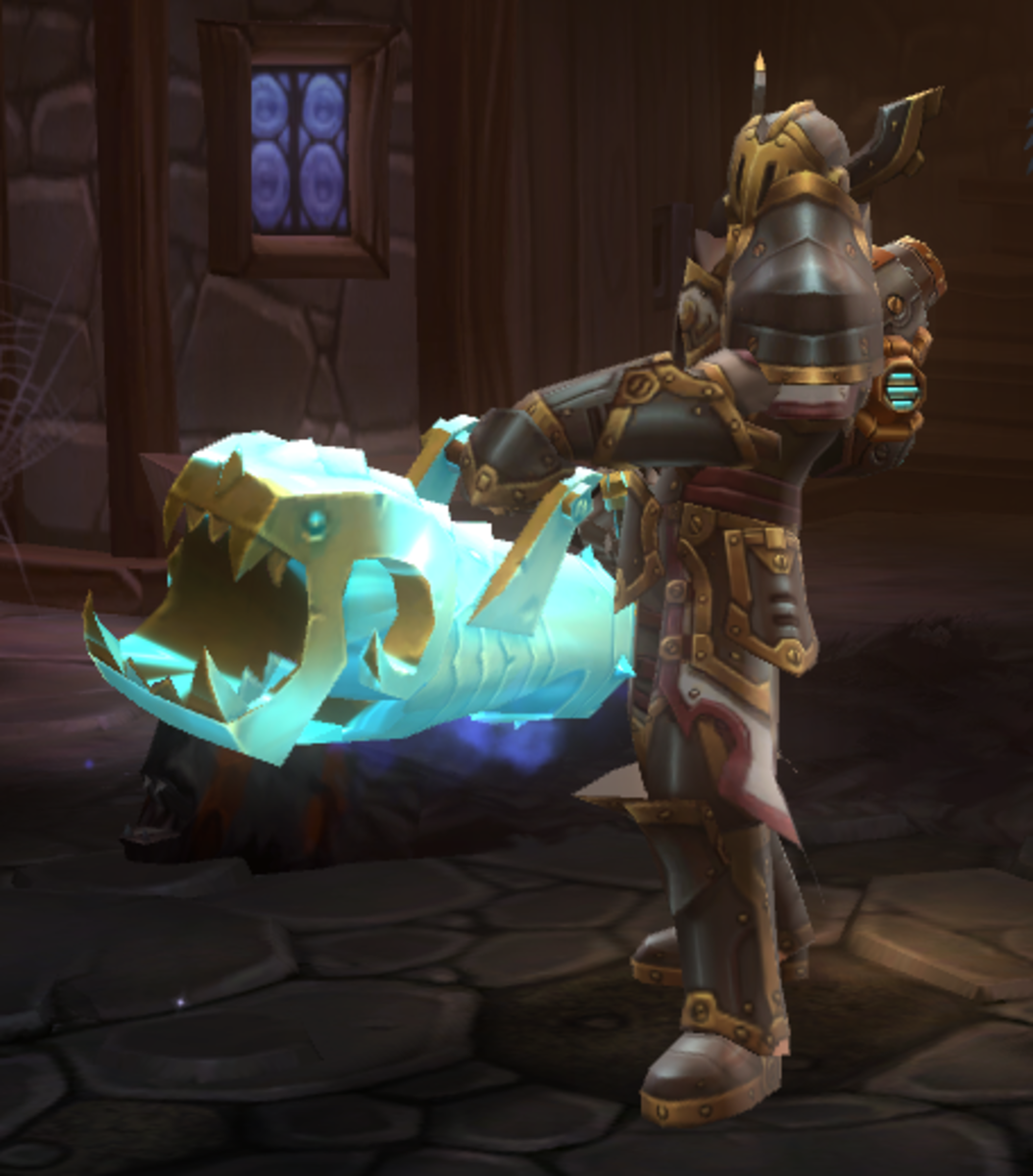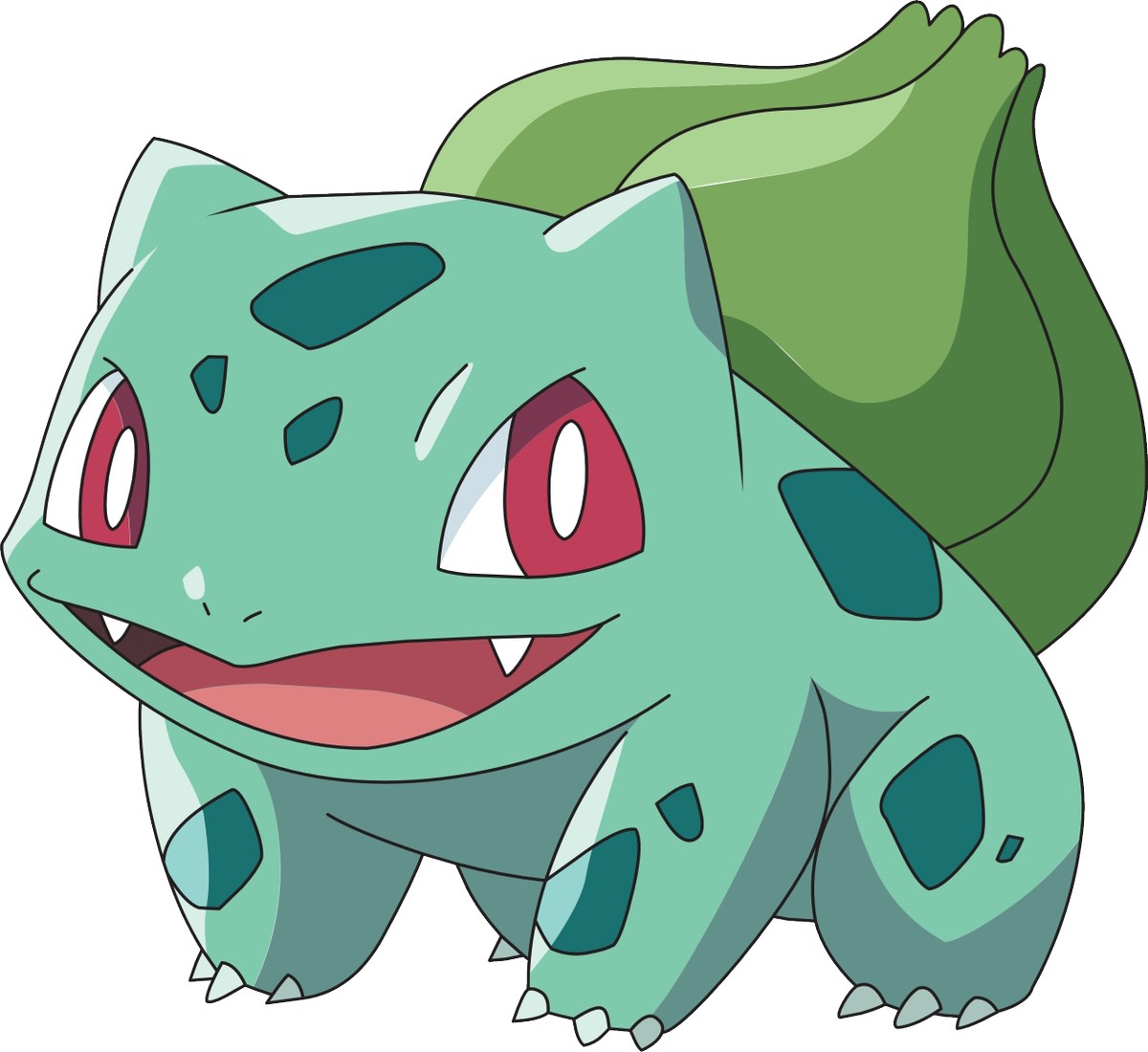Art of Counter-Strike: Study of the Best First-Person-Shooter Ever
What is Counter-Strike?
The founders behind the start of this giant franchise are Minh "Gooseman" Le and Jesse Cliffe. In 1999, Counter-Strike was released as a mod for Half-Life. Le initially expected Counter-Strike to stabilize at a small community of players who merely enjoyed it, but that expectation was soon dwarfed. The Half-Life community went wild - supporting Le and Counter-Strike to an extent that he possibly could not have imagined.
From that point on, the development of Counter-Strike skyrocketed. The community was so supportive that many people began submitting ideas and designs of maps to Le, which a good amount of them still remain in Counter-Strike: Global Offensive. Eventually, Valve corporation, creators of Half-Life, stepped into the field and bought out the rights to the game. Through Valve, Counter-Strike was officially re-released and the co-founders were hired by Valve to work on the game continuously. Counter Strike: Source was released in 2004, and Counter-Strike: Global Offensive was released in 2012.
Counter-Strike consists of a rather simple gameplay. There are always two teams in a match: counter-terrorists and terrorists. In a deathmatch, a team fights to score more points than the other - by a combination of kills and assists. The competitive scene, however, is focused on the game mode: Bomb Defusal. In Bomb Defusal, terrorists' objective is to plant the bomb or eliminate all the counter-terrorists, and counter-terrorists' objective is to defuse the bomb or eliminate all terrorists. Bomb Defusal also runs on an economy system, where a maximum of $16,000 can be held by each player. The money is used to buy guns and equipments at the beginning of every round. The money is gained by winning the round, eliminating an enemy, getting an assist from an elimination, defusing the bomb, planting the bomb, and round loss bonuses.
Although the general gameplay is simple with clear objectives, each round of each match deals with tremendous amount of strategy and mechanical proficiency. And this is the study of what makes Counter-Strike a beautiful, simple and yet sophisticated game.
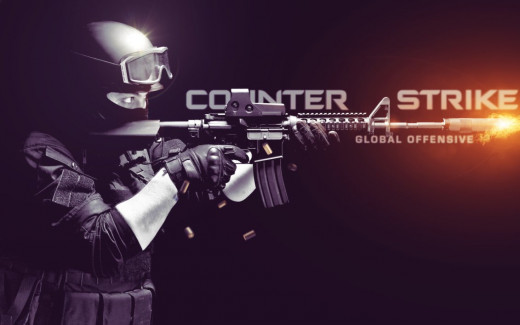
Read this before you continue!
This study is mostly dedicated to Counter-Strike: Global Offensive. Many would argue that the original Counter-Strikes are much more polished in terms of smooth gameplay, but I chose CS:GO for the sake of modernity and reduction of ambiguity in the article.
Game Modes for the "Casuals"
"Casuals" is a word that describes players who refuse to play competitively (ranked mode) possibly due to lack of time, dedication, or enjoyment. Thankfully, as competitive Counter-Strike was made to be, there are plenty of game modes out there offering endless amount of fun for the Casuals. CS:GO offers Demolition, Arms Race, Hostage Rescue, Bomb Defusal, and Deathmatch.There's also a tremendously wide variety of community maps - created by the community, of course.
Deathmatch game mode usually has the most amount of people playing in it - probably because it offers a bit of competition, but not too much to ruin the fun. Each person can strive to be the first place - the one with the highest score, second, or third. The top three people receive a short recognition at the end of each Deathmatch.
In the Arms Race game mode, the option to buy weapons is unavailable. Instead, the game gives you randomized weapons that cycle as you gain kills with them. In order to "level up" to a new weapon, a person must earn 2 kills with the current weapon. The players will have to cycle through a total of 16 weapons and a gold knife kill in the end - to win the match. If a player is killed by a regular knife kill, his weapon "level" decreases once.
The counter-terrorists' main objective in the Hostage Rescue game mode is to rescue hostages. The two hostages are usually located near the Terrorist spawn and counter-terrorists must walk up to them and press the use key to start carrying them back to the hostage rescue zone, which is near counter-terrorists' spawn. If at least one hostage was rescued, then the Counter-Terrorists win. When the hostage is being carried, the carrier is slowed down, but will be compensated with an extra minute to the clock. The hostages are invulnerable, but shooting them will result in penalty for either side.
In Demolition, players do not get to choose their weapons from the buy menu. As a mixture of Gun Game and Bomb Defusal, Throughout twenty rounds, players will be given a weapon at first and they need to eliminate the enemy in order to advance to a new weapon level. If a player has eliminated more than one enemy in a single round, he/she will receive an additional equipment, such as the HE grenade. However, players cannot pick up dropped weapons and grenades. The Counter-Terrorists' objective is to eliminate all terrorists or defuse the bomb. The Terrorists' objective is to eliminate all counter-terrorists or successfully plant and explode the bomb.
In Bomb Defusal, players get to choose their weapons from the buy menu according to the dollar economy system. The Counter-Terrorists' objective is to eliminate all terrorists or defuse the bomb. The Terrorists' objective is to eliminate all counter-terrorists or successfully plant and explode the bomb.The first side to win sixteen rounds will win the match.
Competitive Mode
Competitive mode of Counter-Strike: Global Offensive is what all the fuss is about. New players are placed into a specific rank according to how well they perform in the initial 10 competitive matches. From that initial rank, players can be promoted or demoted to new ranks. There is a photo below with all the current ranks and their designated emblems. Usually when a player is new to competitive play, he/she will be placed into the silver rank - the lowest tier in the ranking system. The ranking system of CS:GO follow a similar ELO system that competitive Chess uses to rank its players. It's simple - a win or a tie can increase your ELO by a different amount according to how well you performed individually in that match. A loss, no matter how well you perform, will decrease your ELO. The ELO system is hidden - meaning a player usually has no idea when he/she will be promoted or demoted to another rank. It's simply a matter of a guessing game - if you have been winning consecutive matches, it's a sign that you are close to promotion. And the opposite - if you have been losing consecutive matches, it's a sign that you are close to demotion.
A competitive match can last anywhere from around 30 minutes to an hour. Each round is two minutes, and there are 30 rounds in total - 15 on CT and T side each. As you climb up the ranks, the skill levels of players become exponentially higher. The apex of the competitive ranks is the Global Elite league, where players are generally considered good enough to play in the professional scene.
Ranks
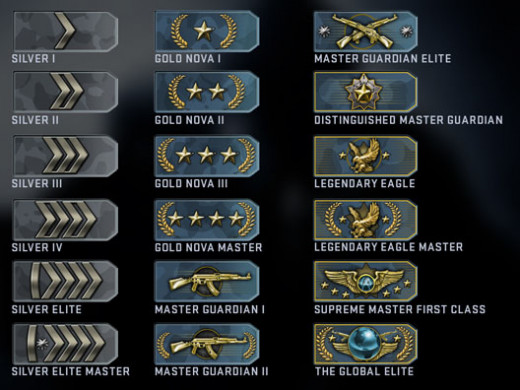
Weapon Skins
Before we get to the compelling mechanics of the game, let's look at one of the primary reasons why CS:GO is appealing to so many people: Weapon Skins
CS:GO is extremely cheap for the endless gameplay it offers. But in exchange for the cheap price of the game itself, CS:GO has a community market where weapon skins are bought and sold for steam wallet money, which is basically real money. It is possible to receive weapon skins from drops that players obtain at the end of each match, but they are usually low-quality and have little to no value. What players really want are the exclusive, high-end, premium, and collectible skins that usually are extremely pleasing to select eyes. These skins can range from as low as $0.50 to $4,000. What's also very cool is that these skins are artworks that the community submits and selects.
There are ways to get these high-priced skins without paying real money. A player can use betting sites to bet skins and be rewarded for choosing the winning team in a professional game. There are also various jackpot/lottery website where players pool in their skins into one pot and through random selection, one or few player(s) will win all the skins. A player can also enter a giveaway by a community member who is willing to give away their skins - popular streamers and tournaments usually host many giveaways. Within the game itself, a player can use the trade-up contract to exchange 10 weapons of the same quality for 1 weapon of higher quality. A player can also buy keys for cases that drop at the end of each game and open them for random skins.
The bittersweet feeling of sitting on exuberant weapon skins of CS:GO is universally addicting and rewarding. Steam (game platform by Valve in which CS:GO runs on), allows players to flaunt their inventory to the public, and that probably stands as one of the top reasons why people love collecting weapon skins.
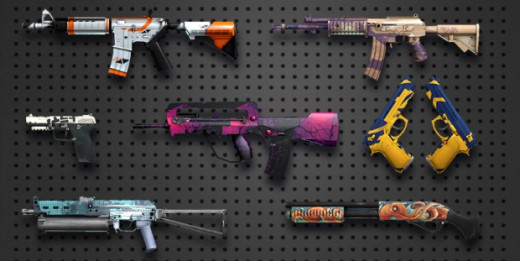
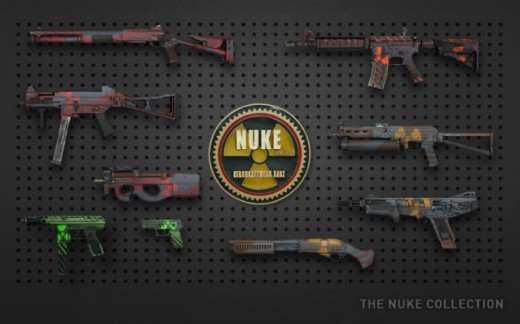
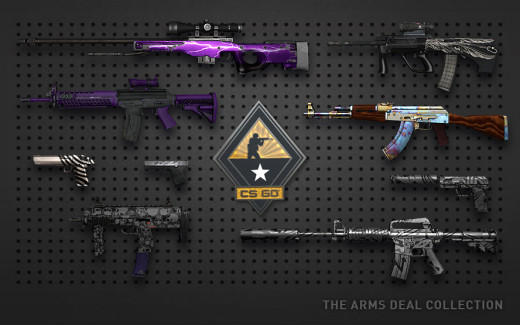
Events and Maps
Counter Strike: Global Offensive have maps that has been played since the original Counter-Strike. It also has maps submitted and selected by the community. Dust 2 is the most popular map in Counter-Strike for its technical symmetry and balance in gameplay of both Terrorist and Counter-Terrorist sides. In a more personal note, I've spent about 400 hours playing in this map and I have yet to get sick of it. That just shows you how excellent this map's re-playability is. There are currently 11 permanent maps in the competitive Bomb Defusal map pool. Every once in a while, there are events, usually called Operation ________, such as Operation Bloodhound, Operation Phoenix, that introduces additional competitive map pool for the duration of the event.
Every detail of the map played in the competitive matches must be in balance and not game-breaking. There are maps in which the balance of gameplay between the CT side and the T side is uneven. However, each team gets to play equal amount of rounds on each side, so that is not a problem. It's the simple, but ironically addicting designs of these maps that somehow consistently attract players to the competition-filled environment.
Maps
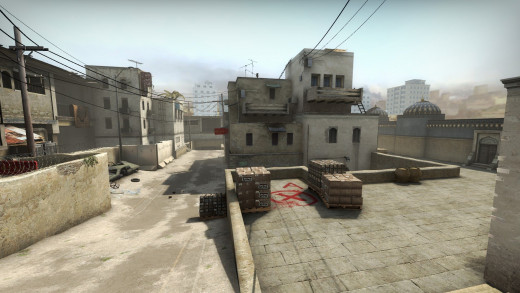
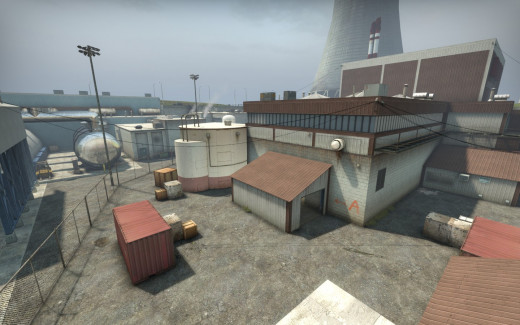
Mechanics Introduction
CS:GO is probably among the world's most difficult games to master. The game has so many mechanical aspects that the skill ceiling becomes technically infinite. No one has ever mastered this game to its fullest potential, and most likely no one ever will. The core mechanics come down to: gun accuracy, map awareness, communication skills, inference skills, equipment utilization, and tactical IQ. In this article, I will only cover these topics because getting specific with the mechanics of the game requires much more research and canvas.
Gun Accuracy
There are a total of 32 guns in this game, and each one requires unique mastery. Meaning, each gun has its own shooting patterns, recoil patterns, and stats that players have to account for. Therefore, professional players usually specialize in just five weapons instead of trying to master all 32 guns in the game. The most popular guns are AK-47 (terrorist) and M4A1-S (counter-terrorists). They are assault rifles and are considered the most reliable weapons in their respective sides. Some players substitute the M4A1-S with the un-silenced version, M4A4, which carry 10 more bullets in a magazine. AWP, the 1-shot sniper rifle, is available for both sides, and is usually the go-to gun for sniper rifle specialists.
The AK-47 and M4A1-S are two completely different guns, but they are "fundamental" guns for all players, and all players must know how to use them to a certain degree. The AK-47 is more powerful than M4A1-S, hitting for more damage with each hit. It also eliminates an enemy with one shot to the head. On the other hand, M4A1-S is more accurate, but less powerful. It requires two hits to the head in order to eliminate an enemy. In exchange for the stealth, M4A1-S also has 10 less bullets than the AK-47. In exchange for more power, the AK-47 packs a much bigger recoil. In CS:GO, assault rifles are usually somewhat accurate for the initial three bullets. After that, the recoil causes your bullets to hit areas you are not aiming at. The good thing is that the recoil is controllable. There are recoil patterns to every automatic gun and once a player is able to master the pattern, most bullets will successfully hit the enemies. On paper, it might sound easy to do. However, each pattern requires many hundreds of hours of practice to master.
AWP, the sniper rifle, requires a whole different set of skills than the assault rifles. As a bolt-action rifle, meaning the gun shoots only once when triggered once, accuracy is the key. At higher levels, the AWPer (that's how players refer to players using the AWP) usually only has two shots in a firefight until the enemy eliminates him/her. Extreme reaction time and tactical position are crucial skills for AWPers. Unlike assault rifles, sniper rifles don't require any bullet patterns to be learned. In exchange, they become high-risk, high-reward guns.
In the "Buy Menu," players can see the stats for each gun. The main attributes that they look for are: damage, accuracy, fire rate, and range (in actuality, no one really looks at the stats, but they are still important to not). The higher the damage, the less hits it will take to eliminate an enemy. The higher the accuracy, the less the gun will recoil. The higher the range, the higher the distance the bullets will travel while maintaining some level of accuracy.
Assault Rifles are all-purpose, meaning they can be good in short-range, medium-range, and long-range gunfights. Submachine Guns (SMGs) are good for short-range, and medium-range. Sniper Rifles are good for medium-range and long-range. Machine Guns are good for short-range and medium-range. Depending on which gun the player uses, he/she will have a different role. Assault Rifles/SMGs/MGs are usually the frontrunners in the firefight, and Sniper Rifles are the supports/long-range specialists in the firefights.
Gun Spray Patterns
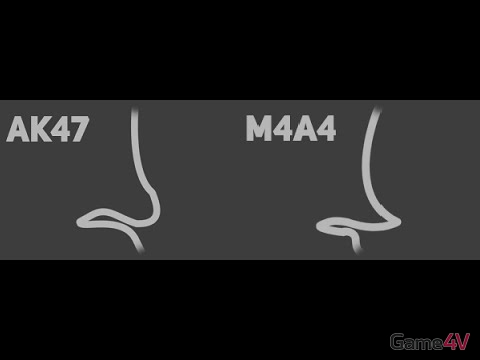
AK47 vs M4A1-S Spray Patterns
Map Awareness and Equipment Utilization
Players' knowledge of the maps plays a huge role in all matches. By knowing all of the tactically advantageous positions, players can set themselves up to gain a huge advantage in firefights. For example, when the offensive player is turning a corner, a defensive player can position himself/herself in a way that they see the offensive player before the offensive player sees him. This allows for a short one-sided gap period that usually is enough for the defensive player to score a kill on the offensive player. Also, some locations in the map allows for a huge field of view, where players are able to watch multiple locations at once. This is particularly useful for counter-terrorist side, where the terrorist might try splitting up to different locations in an attempt to gain a tactical advantage.
Professional players know where to throw grenades in order to land them at a critical spot. The players even bounce them off the walls and floors to position the grenades in the perfect spots. Flashbang grenades are usually used to rush the corners, rush a site, and distract enemies. Decoy grenades are tactical - it stimulates gunfire noises and appears like a player on the minimap. They are generally used for deviation/luring tactics. High Explosive Grenades are regular grenades that explode and deal damage to an area. Smoke grenades provide a smoke screen that players cannot see through, allowing for superior positioning. Knowing when and how to use these grenades are crucial to a team's success.
Armor and Helmet are considered must-buy. Armor allows for extra damage prevention, allowing for the player to be hit with 1 or 2 more bullets than without armor. Helmets are used to prevent one-shot headshot kills from certain guns. These are necessities as long as the players are able to afford them.
Communication and Inference Skills
Teamwork is essential in competitive mode. Players must learn to communicate efficiently and effectively. Learning the names of different locations of the maps will greatly aid in team communication. Too much chatter can cause confusion, and too little chatter can cause lack of teamwork. Quick and correct call-outs are vital for a victory.
Once a teammate has called-out an enemy position for you, then you must be able to infer where the enemy will be. Most likely, the enemy will not be in the same place that your teammate called-out. Therefore, you must use your map and game knowledge to quickly predict where the enemy might be heading towards. In higher skill-levels, the players even engage in mind games through luring/decoy tactics by using utility grenades.
Knowing where players are at all times is a huge advantage, and the team that communicates the most effectively will usually win the match.
Professional Team Communication: Team Cloud9
Tactical IQ
As important as communication is to the success of a team, tactical IQ is just as important. In a team, one player (usually the captain) calls out a strategy that seems most appropriate for their current situation (economically and mentally). For example, in Dust II, there is a strategy where all the players in the Terrorist side rush to the B bomb site as quickly as possible by going through the tunnels. This strategy is used in earlier rounds, when gun advantage/disadvantage is clearly noticeable between the two teams. The terrorist side might rush B site with a gun advantage because by having better weapons, it is easy to overpower the counter-terrorists. Also since counter-terrorists have to split up between A and B site, terrorists will easily outnumber counter-terrorists at each bomb sites (there are exceptions to this, but very rarely). The terrorist side might rush B site even with a gun disadvantage because B site tends to be an easier site to break through. In an A site push, terrorists might face gunfire from enemies on Catwalk and CT-spawn on their long journey towards the site. While as in a B site rush, terrorists will quickly have the tactical advantage once they exit the tunnels onto B site.
No player can know for sure what strategies the enemy team will go for at each start of the round. However, it is somewhat possible for a team to predict what the enemy might do. Just like chess, calling out strategies in CS:GO require mind games and each of the team's "tacticians" have to account for what strategies their opponents will predict. By being steps ahead of the enemy's mind, a team can gain a huge edge. In the end, tactical IQ comes down to good intuition and conception of different strategies.
Final Word
With this informal study, I've only scratched the surface of what CS:GO is consisted of. Consider each section of this article as mere introductory paragraphs of 100-page research papers that can be done on each element of the game. A perfect combination of a straightforward gameplay and sophisticated technicalities will allow CS:GO to dominate the podium of PC-FPS world forever. This game is truly a masterpiece.
CS:GO is available on Steam platform for an affordable price. For more information regarding this game, visit the steam community hub. Thanks for reading!

